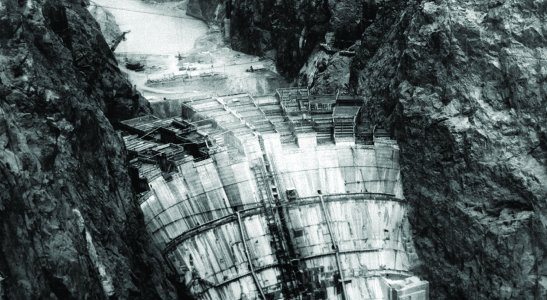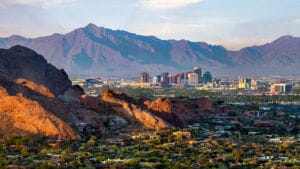In 1912, when it became the nation’s 48th state, Arizona was a challenging place to live. It was sparsely populated with small communities scattered hither and yon. Travel between towns was grueling. The lower desert was unbearably hot in the summer, and water was scarce and unreliable.
Arizona would have had a dim future if it hadn’t engineered a reliable water supply, says Marshall Trimble, Arizona’s official state historian. In 1902, when President Theodore Roosevelt signed the National Reclamation Act, Phoenix was an agricultural community that suffered through wild swings between drought and a flooding Salt River, Trimble says. Farmers and ranchers banded together as the Salt River Valley Water Users’ Association to lobby for federal funding for the legislation’s first water reclamation project — construction of Roosevelt Dam northeast of Phoenix to tame the Salt and store water in Roosevelt Lake for future use.
This was the beginning of what would become Salt River Project (SRP), one of Arizona’s major utilities, and Trimble pegs the dedication of Roosevelt Dam in 1911 as the first step toward a modern Arizona. Today, SRP operates seven dams on the Salt and Verde rivers and delivers more than 1 million acre feet of water annually to Central Arizona.
But as Phoenix became increasingly urbanized, SRP’s 13,000-square-mile watershed couldn’t keep up with demand, and Arizona’s most populated areas were drawing more water out of the ground than was being replenished. As early as 1946, Arizonans began to hear about the need for delivery of Colorado River water to the Phoenix and Tucson population centers via a 336-mile canal called the Central Arizona Project. Construction of the CAP began in 1973 at Lake Havasu, and 20 years and $4 billion later, it was completed south of Tucson. The CAP delivers an average 1.5 million acre-feet of water annually to municipal, agricultural and Native American users in Maricopa, Pima and Pinal counties, where 80 percent of Arizonans live today.
“Without the CAP, we wouldn’t have the population we have today,” says Pam Pickard, president of the CAP board of directors. “We wouldn’t have our economic base. We wouldn’t have the industry we have.”
But the CAP wouldn’t have been possible without another milestone that occurred nearly 60 years earlier — Hoover Dam and its reservoir, Lake Mead, 30 miles southeast of Las Vegas. Hoover Dam, constructed between 1933 and 1936, tamed the Colorado, which Trimble says was even more erratic than the Salt. The dam created reliable water supplies for Arizona’s Colorado River Valley and, eventually, Central and Southern Arizona via the CAP.
Electricity
Electrical power generation in Arizona significantly preceded statehood and provided the “juice” for future development. Another major utility, Arizona Public Service (APS), traces its roots to 1886 in Phoenix. Electricity also came to Tucson in the 1880s, but the forerunner of today’s Tucson Electric Power (TEP) didn’t come about until 1892. SRP began delivering power to an expanding customer base in the 1920s, and created the Salt River Project Agricultural Improvement and Power District in 1937 to operate the utility’s power generation and distribution system.
Statistics from these utilities bear witness to Arizona’s escalating hunger for electricity. TEP had 300 customers in 1903. That grew to 16,000 in 1932; 112,600 in 1970; and more than 400,000 today. TEP generating capacity jumped from 648,000 kilowatts in 1970 to 2,229 megawatts today.
Mergers led to the creation of APS in 1952. At that time, APS served 114,000 power customers with a 324-megawatt capacity. Today, APS serves 1.1 million customers in 11 of the state’s 15 counties with a 6,293-megawatt capability. APS also helped bring nuclear power generation to Arizona. APS operates and owns 29.1 percent of the Palo Verde Nuclear Generating Station located about 50 miles west of Phoenix. The largest nuclear power plant in the U.S., Palo Verde’s three units are capable of producing nearly 4,000 megawatts of electricity.
SRP’s electricity customer base grew to 7,684 in 1940; 169,773 in 1970; and 942,024 by the end of 2010. Another measuring rod — peak power demand — reached an all-time high at SRP in 2006 at 6,590 megawatts.
War, Manufacturing and Refrigeration
According to Trimble, the real turning point for Arizona industry came about in less than a decade during the mid-20th century. After America’s entry into World War II in December 1941, Luke Air Force Base in Glendale and Williams Air Force Base in Mesa became major training facilities for war pilots. Manufacturing for the war also contributed to Arizona’s economy, which continued to grow, Trimble says.
Then two critical milestones occurred closely together, say Trimble and another close observer of Arizona’s history, Grady Gammage Jr.
“There was a lot of home construction in Arizona after the war,” Trimble says. “GIs were moving here to start a new life. Many of them had trained in Arizona and liked the weather.”
Except perhaps for those summer temperatures, and they became less of a problem when affordable air conditioning became available in 1950, Trimble says.
Trimble points to 1950 as the year Arizona moved from a pioneer outpost to a modern state, thanks to refrigeration and a growing population that embraced it. Gammage, who is author of “Phoenix in Perspective: Reflections On Developing the Desert,” says window refrigeration units first appeared in Arizona in 1948. Two years later, Arizona led the nation in the number of window air conditioning units sold. By 1960, there was more central air conditioning in Arizona homes than window units, Gammage says.
“Refrigeration did a couple of things,” Gammage notes. “First, it was one of the critical building blocks that allowed people to move here. Second, it transformed Arizonans’ lifestyles.”
Master-Planned Communities
Arizona is home to countless master-planned residential communities, but the first one — Maryvale — opened in 1955 in West Phoenix as the post-war years exerted their influence. Its developer, John F. Long, wanted to plan and build a community where young people could buy an affordable home, raise a family and work, all in the same area. He named the development after his wife, Mary, and its influence is felt to this day.

“Because Maryvale was a master-planned community and because John did affordable housing, the master plan included a lot of parks, school sites and shopping areas,” says Jim Miller, director of real estate for John F. Long Properties. “It really was where people could live and work. If you lived in Maryvale, you weren’t more than three-quarters of a mile from a park or school. That forced a lot of other builders to adopt the same type of philosophy.”
The first homes sold for as little as $7,400, with a $52-a-month mortgage. The first week the models went on the market, 24,000 people stopped by to take a look. Long built 24,000 homes in Maryvale and by the mid-1990s, he and other developers had mostly finished the community.
Retirement Communities
A year before Maryvale opened, Ben Schleifer introduced a different lifestyle to an older demographic. In 1954, Schleifer opened Youngtown in West Phoenix, the first age-restricted retirement community in the nation, according to research by Melanie Sturgeon, director of the state’s History and Archives Division. No one younger than 50 could live there. By 1963, Youngtown had 1,700 residents and Arizona was on its way to becoming a retirement mecca.
But it was builder Del E. Webb and his construction companies that firmly established the concept of active, age-restricted adult retirement in Arizona with the opening of Sun City on Jan. 1, 1960, next to Youngtown and along Grand Avenue. According to Sturgeon’s research and a magazine observing Sun City’s 50th anniversary, about 100,000 people showed up the first three days to see the golf course, recreation center, swimming pool, shopping center and five model homes. Traffic was backed up for miles. The first homes sold for between $8,500 and $11,750. Sun City had 7,500 residents by 1964 and 42,000 by 1977, the same year Webb decided the community was big enough and he began construction on Sun City West.
Today, Arizona boasts many retirement communities.
Transportation
Two milestones that occurred decades apart cemented Phoenix’s future as Arizona’s population and economic hub.
In 1935, the city bought Sky Harbor International Airport for $100,000. Today, that investment is responsible for a $90 million daily economic impact. Sky Harbor also helped Central Arizona thrive.

“As much as anywhere in the U.S., Phoenix is a creature of good air connections,” Gammage says. “There is no good rail service (in Arizona). There are no real transportation corridors. Sky Harbor has had a huge impact.”
The other milestone occurred 50 years later when the Maricopa Association of Governments approved a $6.5 billion regional freeway plan for Phoenix and voters approved a 20-year, one-half cent sales tax to fund it. By 2008, the Arizona Department of Transportation had completed the construction and Phoenix boasted 137 miles of loop freeways that linked the metro area.
The loop freeways have had a significant impact on shaping Phoenix and, ultimately, Arizona, says Dennis Smith, MAG executive director.
“The loop freeways resulted in a distribution of job centers around the Valley,” Smith says. “That allows every part of the Valley to achieve its dream and have employment closer to where the homes are. That distributes the wealth throughout the Valley.”
Smith says the freeways also extended the Valley’s reach to Yavapai, Pinal and Pima counties, creating a megapolitan area known as the Sun Corridor.



